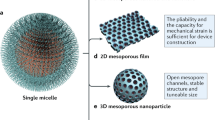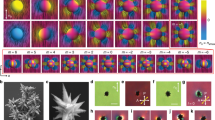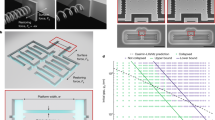Abstract
In a physically confined environment, interfacial interactions, symmetry breaking, structural frustration and confinement-induced entropy loss can play dominant roles in determining molecular organization. Here we present a systematic study of the confined assembly of silica–surfactant composite mesostructures within cylindrical nanochannels of varying diameters. Using exactly the same precursors and reaction conditions that form the two-dimensional hexagonal SBA-15 mesostructured thin film, unprecedented silica mesostructures with chiral mesopores such as single- and double-helical geometries spontaneously form inside individual alumina nanochannels. On tightening the degree of confinement, a transition is observed in the mesopore morphology from a coiled cylindrical to a spherical cage-like geometry. Self-consistent field calculations carried out to account for the observed mesostructures accord well with experiment. The mesostructures produced by confined syntheses are useful as templates for fabricating highly ordered mesostructured nanowires and nanowire arrays.
This is a preview of subscription content, access via your institution
Access options
Subscribe to this journal
Receive 12 print issues and online access
$259.00 per year
only $21.58 per issue
Buy this article
- Purchase on Springer Link
- Instant access to full article PDF
Prices may be subject to local taxes which are calculated during checkout






Similar content being viewed by others
References
Kellogg, G. J. et al. Observed surface energy effects in confined diblock copolymers. Phys. Rev. Lett. 76, 2503–2506 (1996).
Chen, H. Y. & Fredrickson, G. H. Morphologies of ABC triblock copolymer thin films. J. Chem. Phys. 116, 1137–1146 (2002).
Lambooy, P. et al. Observed frustration in confined block-copolymers. Phys. Rev. Lett. 72, 2899–2902 (1994).
Zhu, S. et al. Confinement-induced miscibility in polymer blends. Nature 400, 49–51 (1999).
Sevink, G. J. A., Zvelindovsky, A. V., Fraaije, J. G. E. M. & Huinink, H. P. Morphology of symmetric block copolymer in a cylindrical pore. J. Chem. Phys. 115, 8226–8230 (2001).
Zhao, D. Y., Huo, Q. S., Feng, J. L., Chmelka, B. F. & Stucky, G. D. Nonionic triblock and star diblock copolymer and oligomeric surfactant syntheses of highly ordered, hydrothermally stable, mesoporous silica structures. J. Am. Chem. Soc. 120, 6024–6036 (1998).
Zhao, D. Y. et al. Triblock copolymer syntheses of mesoporous silica with periodic 50 to 300 angstrom pores. Science 279, 548–552 (1998).
Ying, J. Y., Mehnert, C. P. & Wong, M. S. Synthesis and applications of supramolecular-templated mesoporous materials. Angew. Chem. Int. Edn 38, 56–77 (1999).
Tsai, C. Y., Tam, S. Y., Lu, Y. F. & Brinker, C. J. Dual-layer asymmetric microporous silica membranes. J. Membrane Sci. 169, 255–268 (2000).
Yang, P. D. et al. Mirrorless lasing from mesostructured waveguides patterned by soft lithography. Science 287, 465–467 (2000).
Masuda, H. & Satoh, M. Fabrication of gold nanodot array using anodic porous alumina as an evaporation mask. Jpn J. Appl. Phys. 35, L126–L129 (1996).
Lu, Y. F. et al. Continuous formation of supported cubic and hexagonal mesoporous films by sol–gel dip-coating. Nature 389, 364–368 (1997).
Zhao, D. et al. Continuous mesoporous silica films with highly ordered large pore structures. Adv. Mater. 10, 1380–1385 (1998).
Alberius, P. C. A. et al. General predictive syntheses of cubic, hexagonal, and lamellar silica and titania mesostructured thin films. Chem. Mater. 14, 3284–3294 (2002).
Crepaldi, E. L. et al. Controlled formation of highly organized mesoporous titania thin films: From mesostructured hybrids to mesoporous nanoanatase TiO2 . J. Am. Chem. Soc. 125, 9770–9786 (2003).
Brinker, C. J., Lu, Y. F., Sellinger, A. & Fan, H. Y. Evaporation-induced self-assembly: nanostructures made easy. Adv. Mater. 11, 579–585 (1999).
Joo, S. H., Ryoo, R., Kruk, M. & Jaroniec, M. Evidence for general nature of pore interconnectivity in 2-dimensional hexagonal mesoporous silicas prepared using block copolymer templates. J. Phys. Chem. B 106, 4640–4646 (2002).
Holmqvist, P., Alexandridis, P. & Lindman, B. Modification of the microstructure in block copolymer–water–'oil' systems by varying the copolymer composition and the 'oil' type: Small-angle X-ray scattering and deuterium-NMR investigation. J. Phys. Chem. B 102, 1149–1158 (1998).
Matsen, M. W. Phase-behavior of block-copolymer homopolymer blends. Macromolecules 28, 5765–5773 (1995).
Schmid, F. Self-consistent-field theories for complex fluids. J. Phys. Condensed Matter 10, 8105–8138 (1998).
Janert, P. K. & Schick, M. Phase behavior of binary homopolymer/diblock blends: Temperature and chain length dependence. Macromolecules 31, 1109–1113 (1998).
Fasolka, M. J. & Mayes, A. M. Block copolymer thin films: Physics and applications. Annu. Rev. Mater. Res. 31, 323–355 (2001).
Jirage, K. B., Hulteen, J. C. & Martin, C. R. Nanotubule-based molecular-filtration membranes. Science 278, 655–658 (1997).
Yamaguchi, A. et al. Self-assembly of a silica-surfactant nanocomposite in a porous alumina membrane. Nature Mater. 3, 337–341 (2004).
Lu, Q. Y., Gao, F., Komarneni, S. & Mallouk, T. E. Ordered SBA-15 nanorod arrays inside a porous alumina membrane. J. Am. Chem. Soc. 126, 8650–8651 (2004).
Manna, L., Milliron, D. J., Meisel, A., Scher, E. C. & Alivisatos, A. P. Controlled growth of tetrapod-branched inorganic nanocrystals. Nature Mater. 2, 382–385 (2003).
Wu, Y. Y., Fan, R. & Yang, P. D. Block-by-block growth of single-crystalline Si/SiGe superlattice nanowires. Nano Lett. 2, 83–86 (2002).
Bjork, M. T. et al. One-dimensional steeplechase for electrons realized. Nano Lett. 2, 87–89 (2002).
Gudiksen, M. S., Lauhon, L. J., Wang, J., Smith, D. C. & Lieber, C. M. Growth of nanowire superlattice structures for nanoscale photonics and electronics. Nature 415, 617–620 (2002).
Maurits, N. M. & Fraaije, J. G. E. M. Mesoscopic dynamics of copolymer melts: From density dynamics to external potential dynamics using nonlocal kinetic coupling. J. Chem. Phys. 107, 5879–5889 (1997).
Fredrickson, G. H., Ganesan, V. & Drolet, F. Field-theoretic computer simulation methods for polymers and complex fluids. Macromolecules 35, 16–39 (2002).
Sides, S. W. & Fredrickson, G. H. Parallel algorithm for numerical self-consistent field theory simulations of block copolymer structure. Polymer 44, 5859–5866 (2003).
Acknowledgements
This work was supported by the National Science Foundation under award number DMR 01-20967 and award number DMR 02-33728, and partially supported by the MRSEC Program of the National Science Foundation under award no. DMR 00-80034 and by an IBM Faculty Award. We thank R. C. Hayward and T. Livneh for helpful discussions.
Author information
Authors and Affiliations
Corresponding author
Ethics declarations
Competing interests
The authors declare no competing financial interests.
Supplementary information
Supplementary Information, Fig. S1
Supplementary Information, Fig. S2 (PDF 5108 kb)
Supplementary Information, Fig. S3
Supplementary Information, Fig. S4
Supplementary Information, Fig. S5
Supplementary Information, Fig. S6
Supplementary Information, Fig. S7
Supplementary Information, Fig. S8
Rights and permissions
About this article
Cite this article
Wu, Y., Cheng, G., Katsov, K. et al. Composite mesostructures by nano-confinement. Nature Mater 3, 816–822 (2004). https://doi.org/10.1038/nmat1230
Received:
Accepted:
Published:
Issue Date:
DOI: https://doi.org/10.1038/nmat1230
This article is cited by
-
Twisting, untwisting, and retwisting of elastic Co-based nanohelices
Nature Communications (2023)
-
Emulsion confined block copolymer self-assembly: Recent progress and prospect
Nano Research (2023)
-
Archimedean lattices emerge in template-directed eutectic solidification
Nature (2020)
-
Block Copolymer Colloidal Particles with Unique Structures through Three-dimensional Confined Assembly and Disassembly
Chinese Journal of Polymer Science (2019)
-
Transformable masks for colloidal nanosynthesis
Nature Communications (2018)



